Effects of Modified Metakaolin Using Nano-Silica on the Mechanical Properties and Durability of Concrete
Abstract
:1. Introduction
2. Materials
2.1. Mix Design Optimization Using Response Surface Method (RSM)
2.2. Trial Mix Proportions for Achieving Desired Compressive Strength
3. Mixing, Molding, and Testing of Specimen
4. Results and Discussion
4.1. Investigating the Effects on the Mechanical Properties
4.1.1. Effect of NS and MK on Compressive Strength
4.1.2. Effects of NS and MK on Split Tensile and Flexural Strength
4.2. Effects of MK and NS on the Durability Characteristics
4.2.1. Water Absorption
4.2.2. Rapid Chloride Permeability Test
4.2.3. Chloride Penetration Depth
4.2.4. Mercury Intrusion Porosimetry
4.2.5. Field-Emission Scanning Electron Microscopy (FESEM)
4.3. Correlation of Responses
4.4. Statistical Assessment and Optimization of Concrete Containing MK and NS
4.5. Verification of Data for the Optimum Replacement Ratios
5. Conclusions
Author Contributions
Funding
Acknowledgments
Conflicts of Interest
References
- Zahedi, M.; Ramezanianpour, A.A.; Ramezanianpour, A.M. Evaluation of the mechanical properties and durability of cement mortars containing nanosilica and rice husk ash under chloride ion penetration. Constr. Build. Mater. 2015, 78, 354–361. [Google Scholar] [CrossRef]
- Bagheri, A.R.; Zanganeh, H. Comparison of rapid tests for evaluation of chloride resistance of concretes with supplementary cementitious materials. J. Mater. Civ. Eng. 2012, 24, 1175–1182. [Google Scholar] [CrossRef]
- Song, H.W.; Lee, C.H.; Ann, K.Y. Factors influencing chloride transport in concrete structures exposed to marine environments. Cem. Concr. Compos. 2008, 30, 113–121. [Google Scholar] [CrossRef]
- Pilvar, A.; Ramezanianpour, A.A.; Rajaie, H. New method development for evaluation concrete chloride ion permeability. Constr. Build. Mater. 2015, 93, 790–797. [Google Scholar] [CrossRef]
- Zahid, M.; Shafiq, N.; Jalal, A. Investigating the effects of solarcure curing method on the compressive strength, microstructure, and polymeric reaction of fly ash based geopolymer. Constr. Build. Mater. 2018, 181, 227–237. [Google Scholar] [CrossRef]
- Kumar, R.; Mohd Yaseen, A.Y.B.; Shafiq, N.; Jalal, A. Influence of metakaolin, fly ash and nano silica on mechanical and durability properties of concrete. Key Eng. Mater. 2017, 744. [Google Scholar] [CrossRef]
- Valipour, M.; Pargar, F.; Shekarchi, M.; Khani, S. Comparing a natural pozzolan, zeolite, to metakaolin and silica fume in terms of their effect on the durability characteristics of concrete: A laboratory study. Constr. Build. Mater. 2013, 41, 879–888. [Google Scholar] [CrossRef]
- Gesoǧlu, M.; Güneyisi, E.; Özturan, T.; Mermerdaş, K. Permeability properties of concretes with high reactivity metakaolin and calcined impure kaolin. Mater. Struct. Constr. 2014, 47, 709–728. [Google Scholar] [CrossRef]
- Zahid, M.; Shafiq, N.; Nuruddin, M.F.; Nikbakht, E.; Jalal, A. Effect of Partial Replacement of Fly Ash by Metakaolin on Strength Development of Fly Ash Based Geopolymer Mortar. Key Eng. Mater. 2017, 744, 131–135. [Google Scholar] [CrossRef]
- Sabir, B.B.; Wild, S.; Bai, J. Metakaolin and calcined clays as pozzolans for concrete: a review. Cem. Concr. Compos. 2001, 23, 441–454. [Google Scholar] [CrossRef]
- Dinakar, P.; Manu, S.N. Concrete mix design for high strength self-compacting concrete using metakaolin. Mater. Des. 2014, 60, 661–668. [Google Scholar] [CrossRef]
- Ambroise, J.; Maximilien, S.; Pera, J. Properties of Metakaolin blended cements. Adv. Cem. Based Mater. 1994, 1, 161–168. [Google Scholar] [CrossRef]
- Parande, A.K.; Ramesh Babu, B.; Aswin Karthik, M.; Deepak Kumaar, K.K.; Palaniswamy, N. Study on strength and corrosion performance for steel embedded in metakaolin blended concrete/mortar. Constr. Build. Mater. 2008, 22, 127–134. [Google Scholar] [CrossRef]
- Wild, S.; Khatib, J.M.; Jones, A. Relative strength, pozzolanic activity and cement hydration in superplasticised metakaolin concrete. Cem. Concr. Res. 1996, 26, 1537–1544. [Google Scholar] [CrossRef]
- Kim, H.S.; Lee, S.H.; Moon, H.Y. Strength properties and durability aspects of high strength concrete using Korean metakaolin. Constr. Build. Mater. 2007, 21, 1229–1237. [Google Scholar] [CrossRef]
- Mardani-Aghabaglou, A.; Inan Sezer, G.; Ramyar, K. Comparison of fly ash, silica fume and metakaolin from mechanical properties and durability performance of mortar mixtures view point. Constr. Build. Mater. 2014, 70, 17–25. [Google Scholar] [CrossRef]
- Nazari, A.; Riahi, S. The effects of SiO2 nanoparticles on physical and mechanical properties of high strength compacting concrete. Compos. Part B Eng. 2011, 42, 570–578. [Google Scholar] [CrossRef]
- Li, H.; Xiao, H.; Yuan, J.; Ou, J. Microstructure of cement mortar with nano-particles. Compos. Part B Eng. 2004, 35, 185–189. [Google Scholar] [CrossRef]
- Jalal, M.; Pouladkhan, A.; Harandi, O.F.; Jafari, D. Comparative study on effects of Class F fly ash, nano silica and silica fume on properties of high-performance self-compacting concrete. Constr. Build. Mater. 2015, 94, 90–104. [Google Scholar] [CrossRef]
- Said, A.M.; Zeidan, M.S.; Bassuoni, M.T.; Tian, Y. Properties of concrete incorporating nano-silica. Constr. Build. Mater. 2012, 36, 838–844. [Google Scholar] [CrossRef]
- Zhang, M.H.; Islam, J.; Peethamparan, S. Use of nano-silica to increase early strength and reduce setting time of concretes with high volumes of slag. Cem. Concr. Compos. 2012, 34, 650–662. [Google Scholar] [CrossRef]
- Ghafari, E.; Costa, H.; Júlio, E.; Portugal, A.; Durães, L. The effect of nanosilica addition on flowability, strength, and transport properties of ultra-high performance concrete. Mater. Des. 2014, 59, 1–9. [Google Scholar] [CrossRef]
- Muhammad, Z.; Nasir, S.; Isa, M.H.; Gil, L. Statistical modeling and mix design optimization of fly ash based engineered geopolymer composite using response surface methodology. Clean. Prod. 2018, 194. [Google Scholar]
- Aldahdooh, M.A.A.; Muhamad Bunnori, N.; Megat Johari, M.A. Evaluation of ultra-high-performance-fiber reinforced concrete binder content using the response surface method. Mater. Des. 2013, 52, 957–965. [Google Scholar] [CrossRef]
- Abyaneh, M.R.Z.; Mousavi, S.M.; Mehran, A.; Hoseini, S.M.M.; Naderi, S.; Irandoost, F.M. Effects of Nano-Silica on Permeability of Concrete and Steel Bars Reinforcement Corrosion 1. Aust. J. Basic Appl. Sci. 2013, 7, 464–467. [Google Scholar]
- Ganesh, P.; Ramachandra Murthy, A.; Sundar Kumar, S.; Mohammed Saffiq Reheman, M.; Iyer, N.R. Effect of nanosilica on durability and mechanical properties of high-strength concrete. Mag. Concr. Res. 2015, 68, 229–236. [Google Scholar] [CrossRef]
- Isfahani, F.T.; Redaelli, E.; Lollini, F.; Li, W.; Bertolini, L. Effects of Nanosilica on Compressive Strength and Durability Properties of Concrete with Different Water to Binder Ratios. Adv. Mater. Sci. Eng. 2016, 2016, 16. [Google Scholar]
- Dinakar, P.; Sahoo, P.K.; Sriram, G. Effect of Metakaolin Content on the Properties of High Strength Concrete. Int. J. Concr. Struct. Mater. 2013, 7, 215–223. [Google Scholar] [CrossRef] [Green Version]
- Kim, H.K.; Hwang, E.A.; Lee, H.K. Impacts of metakaolin on lightweight concrete by type of fine aggregate. Const. Build. Mater. 2012, 36, 719–726. [Google Scholar] [CrossRef]
- Singh, L.P.; Karade, S.R.; Bhattacharyya, S.K.; Yousuf, M.M.; Ahalawat, S. Beneficial role of nanosilica in cement-based materials--A review. Constr. Build. Mater. 2013, 47, 1069–1077. [Google Scholar] [CrossRef]
- Khaloo, A.; Mobini, M.H.; Hosseini, P. Influence of different types of nano-SiO2 particles on properties of high-performance concrete. Constr. Build. Mater. 2016, 113, 188–201. [Google Scholar] [CrossRef]
- Du, H.; Du, S.; Liu, X. Durability performances of concrete with nano-silica. Constr. Build. Mater. 2014, 73, 705–712. [Google Scholar] [CrossRef] [Green Version]
- Quercia, G.; Spiesz, P.; Hüsken, G.; Brouwers, H.J.H. SCC modification by use of amorphous nano-silica. Cem. Concr. Compos. 2014, 45, 69–81. [Google Scholar] [CrossRef]
- Khatib, J.M.; Clay, R.M. Absorption characteristics of metakaolin concrete. Cem. Concr. Res. 2004, 34, 19–29. [Google Scholar] [CrossRef]
- Ramezanianpour, A.A.; Bahrami Jovein, H. Influence of metakaolin as supplementary cementing material on strength and durability of concretes. Constr. Build. Mater. 2012, 30, 470–479. [Google Scholar] [CrossRef]
- Al-Alaily, H.S.; Hassan, A.A.A. Time-dependence of chloride diffusion for concrete containing metakaolin. J. Build. Eng. 2016, 7, 159–169. [Google Scholar] [CrossRef]
- Abbas, R.; Abo-El-Enein, S.A.; Ezzat, E.S. Properties, and durability of metakaolin blended cements: Mortar and concrete. Mater. Constr. 2010, 60, 33–49. [Google Scholar] [CrossRef]
- Zhang, M.; Li, H. Pore structure and chloride permeability of concrete containing nano-particles for pavement. Constr. Build. Mater. 2011, 25, 608–616. [Google Scholar] [CrossRef]
- Shaikh, F.U.A.; Supit, S.W.M. Chloride induced corrosion durability of high volume fly ash concretes containing nano particles. Constr. Build. Mater. 2015, 99, 208–225. [Google Scholar] [CrossRef]
- Senff, L.; Hotza, D.; Repette, W.L.; Ferreira, V.M.; Labrincha, J.A. Mortars with nano-SiO2 and micro-SiO2 investigated by experimental design. Constr. Build. Mater. 2010, 24, 1432–1437. [Google Scholar] [CrossRef]
- Barbhuiya, S.; Mukherjee, S.; Nikraz, H. Effects of nano-Al2O3 on early-age microstructural properties of cement paste. Constr. Build. Mater. 2014, 52, 189–193. [Google Scholar] [CrossRef]
- Duan, P.; Shui, Z.; Chen, W.; Shen, C. Effects of metakaolin, silica fume and slag on pore structure, interfacial transition zone, and compressive strength of concrete. Constr. Build. Mater. 2013, 44, 1–6. [Google Scholar] [CrossRef]
- Poon, C.S.; Kou, S.C.; Lam, L. Compressive strength, chloride diffusivity and pore structure of high-performance metakaolin and silica fume concrete. Constr. Build. Mater. 2006, 20, 858–865. [Google Scholar] [CrossRef]
- Güneyisi, E.; Mermerda, K. Comparative study on strength, sorptivity, and chloride ingress characteristics of air-cured and water-cured concretes modified with metakaolin. Mater. Struct. 2007, 40, 1161. [Google Scholar] [CrossRef]
- Güneyisi, E.; Gesoǧlu, M.; Algin, Z.; Mermerdaş, K. Optimization of concrete mixture with hybrid blends of metakaolin and fly ash using response surface method. Compos. Part B Eng. 2014, 60, 707–715. [Google Scholar] [CrossRef]
- Bestgen, J.O.; Cetin, B.; Tanyu, B.F. Effects of extraction methods and factors on leaching of metals from recycled concrete aggregates. Environ. Sci. Pollut. Res. 2016, 23, 12983–13002. [Google Scholar] [CrossRef] [PubMed]
- Rezaifar, O.; Hasanzadeh, M.; Gholhaki, M. Concrete made with hybrid blends of crumb rubber and metakaolin: Optimization using response surface method. Constr. Build. Mater. 2016, 123, 59–68. [Google Scholar] [CrossRef]
- Feng, X.; Faisal, R.; Zahid, M. Experimental investigation and statistical modeling of frp confined ruc using response surface methodology. Civ. Eng. J. 2019, 5, 268–283. [Google Scholar] [CrossRef]


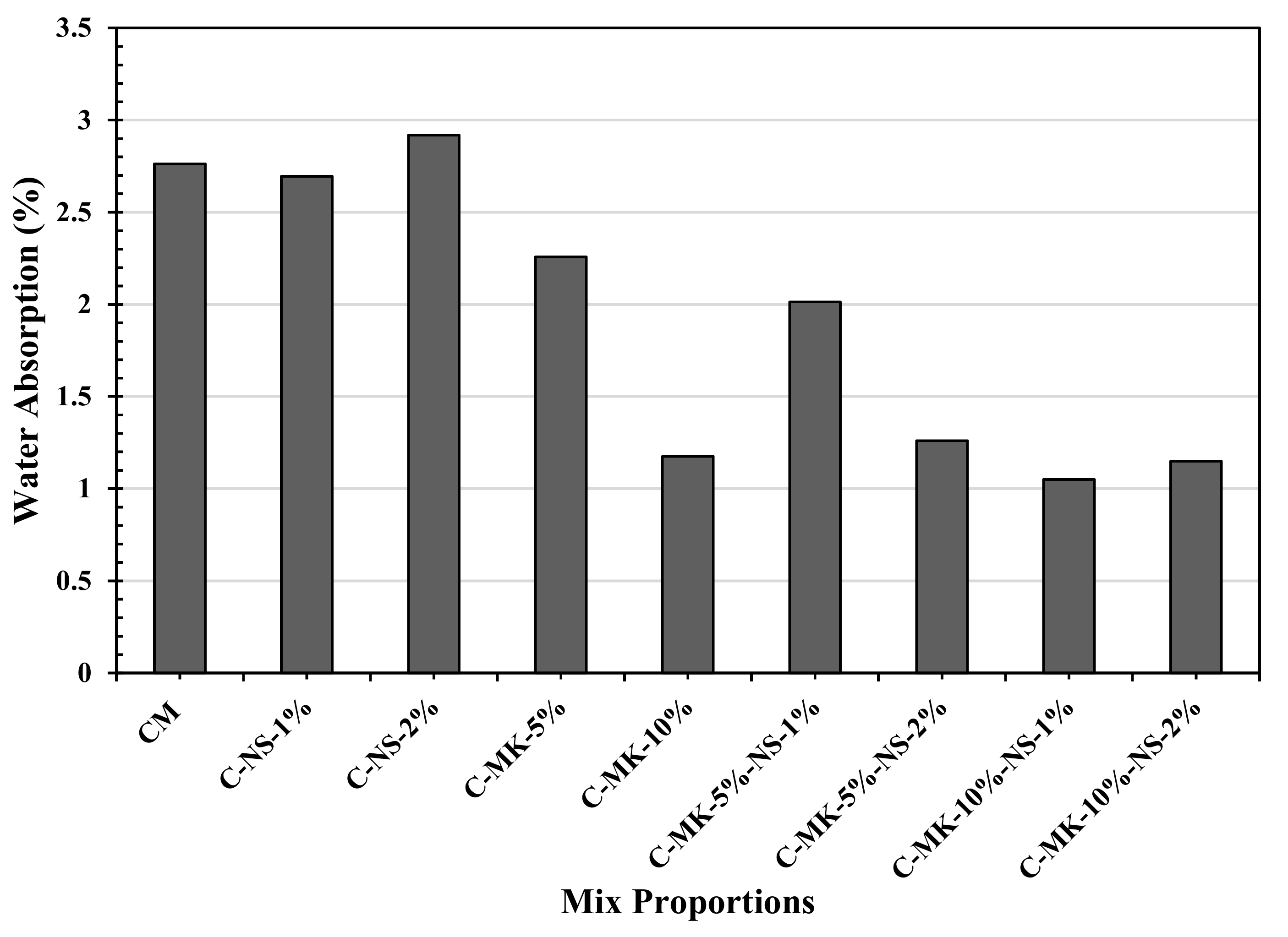
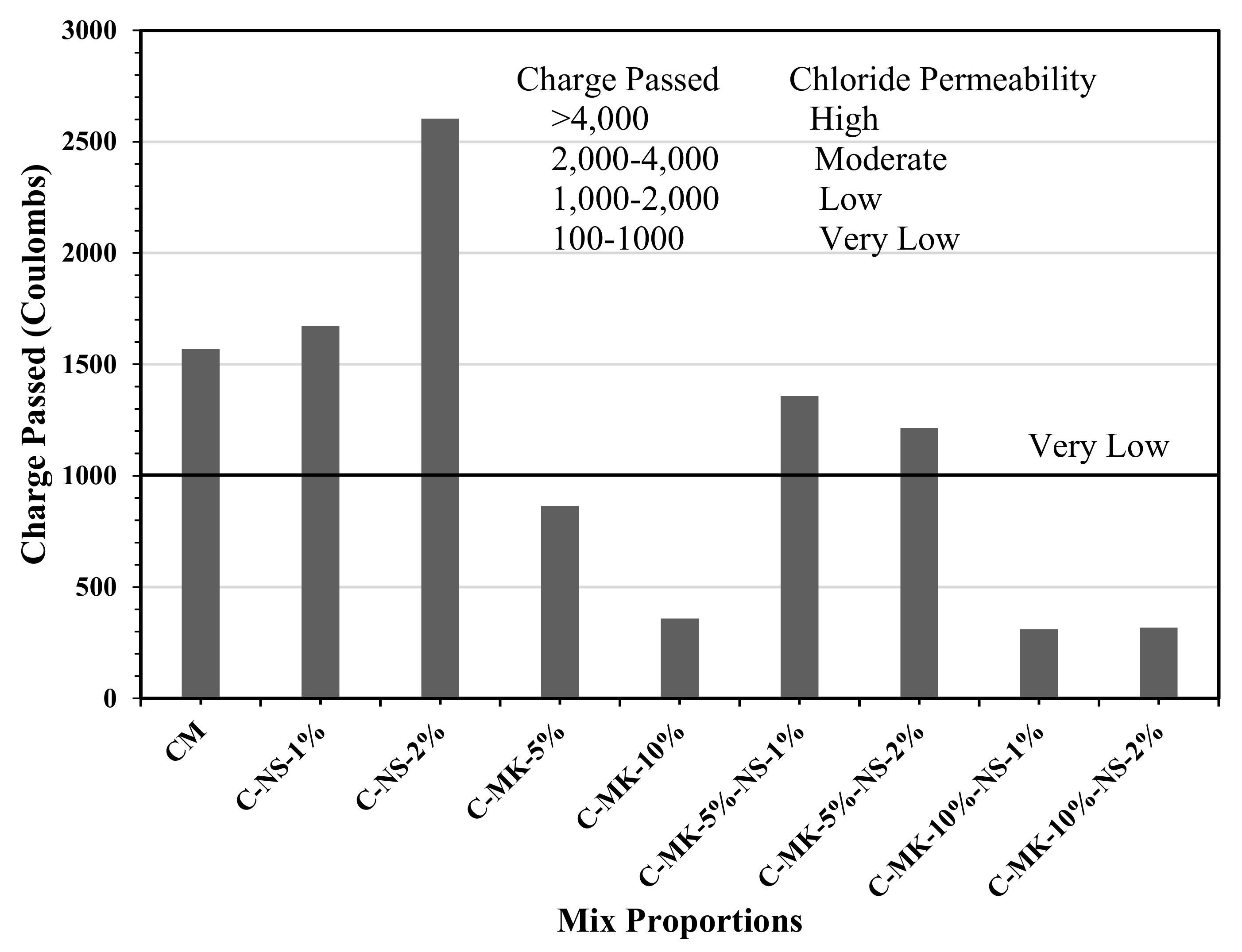
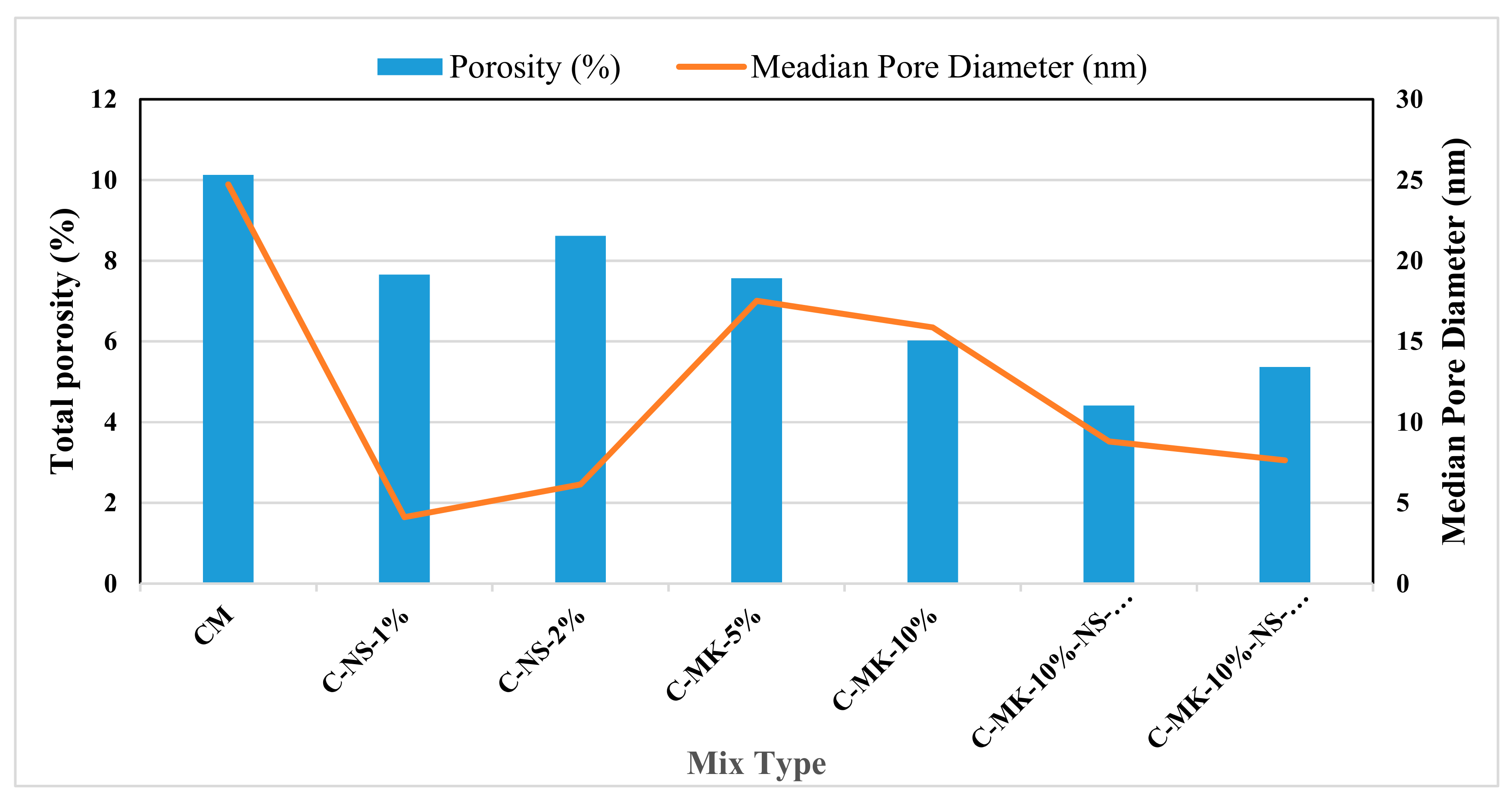
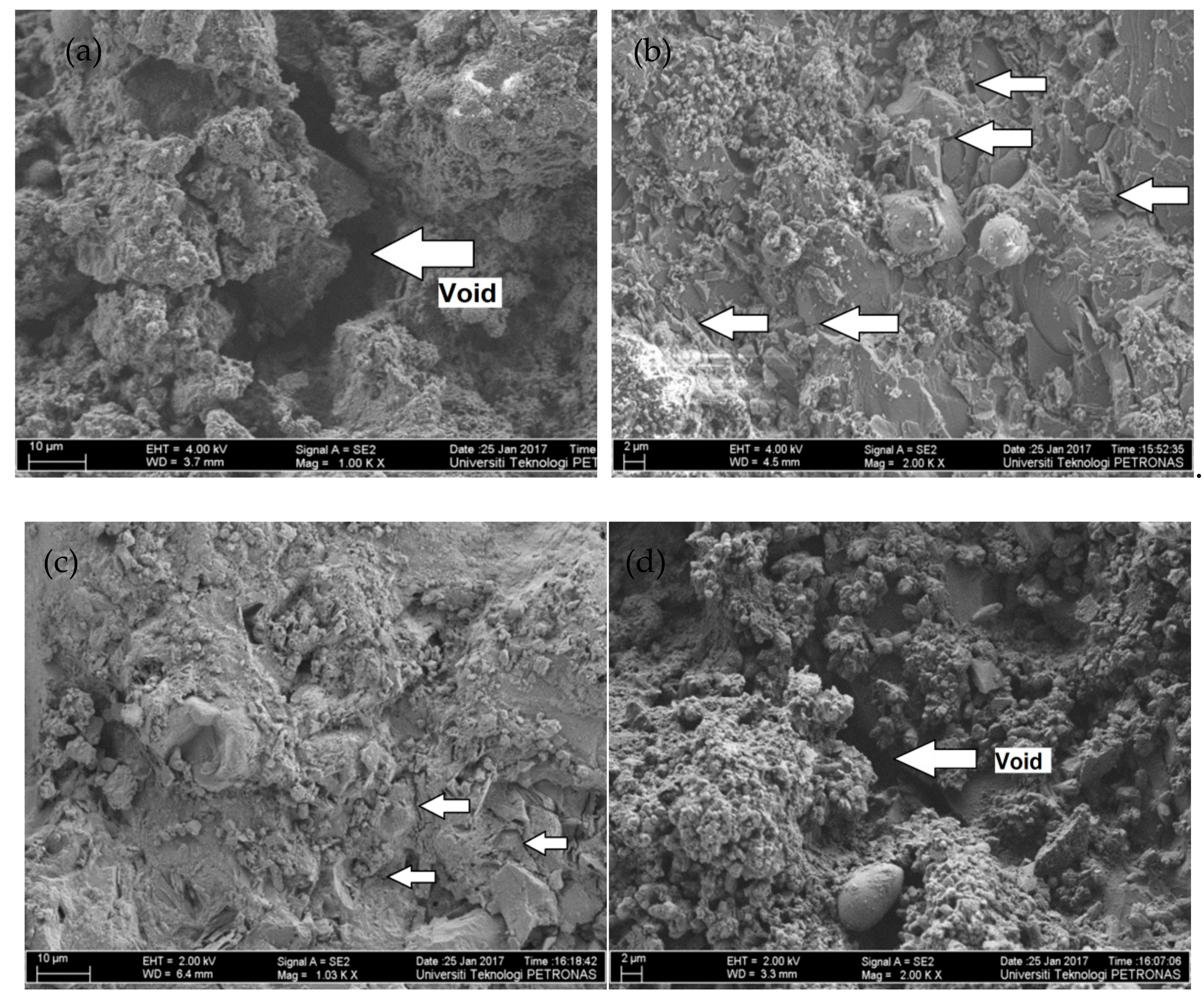



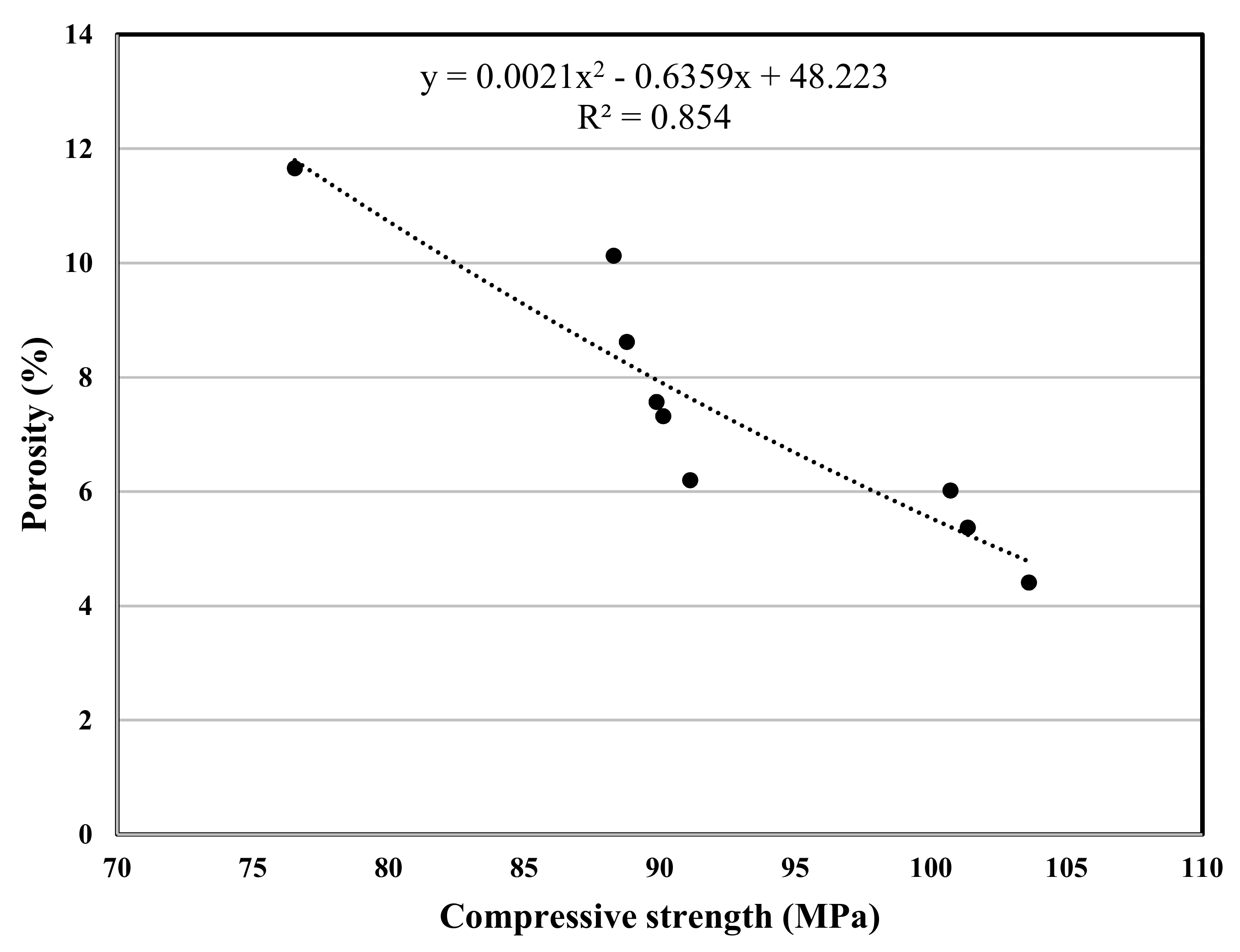
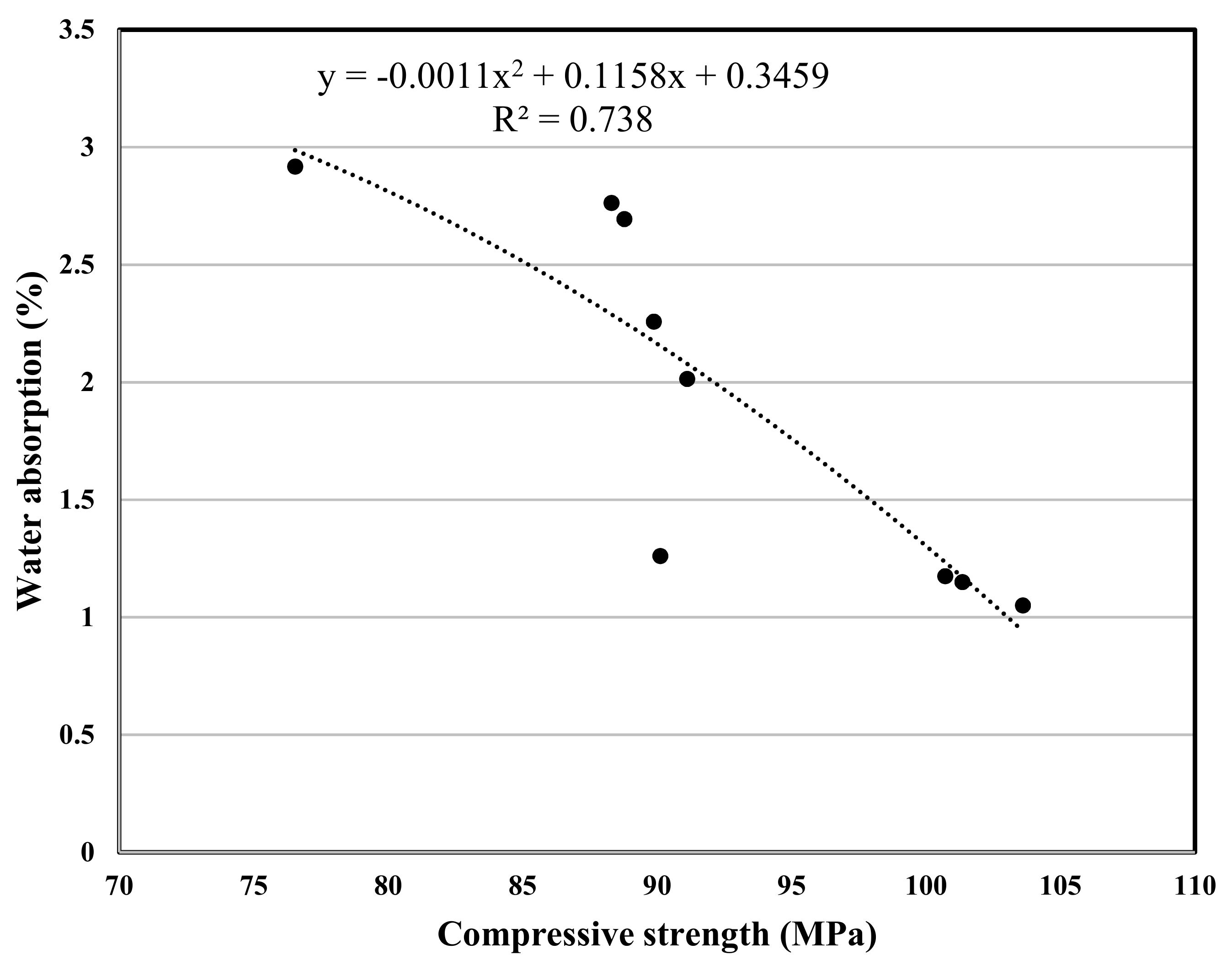
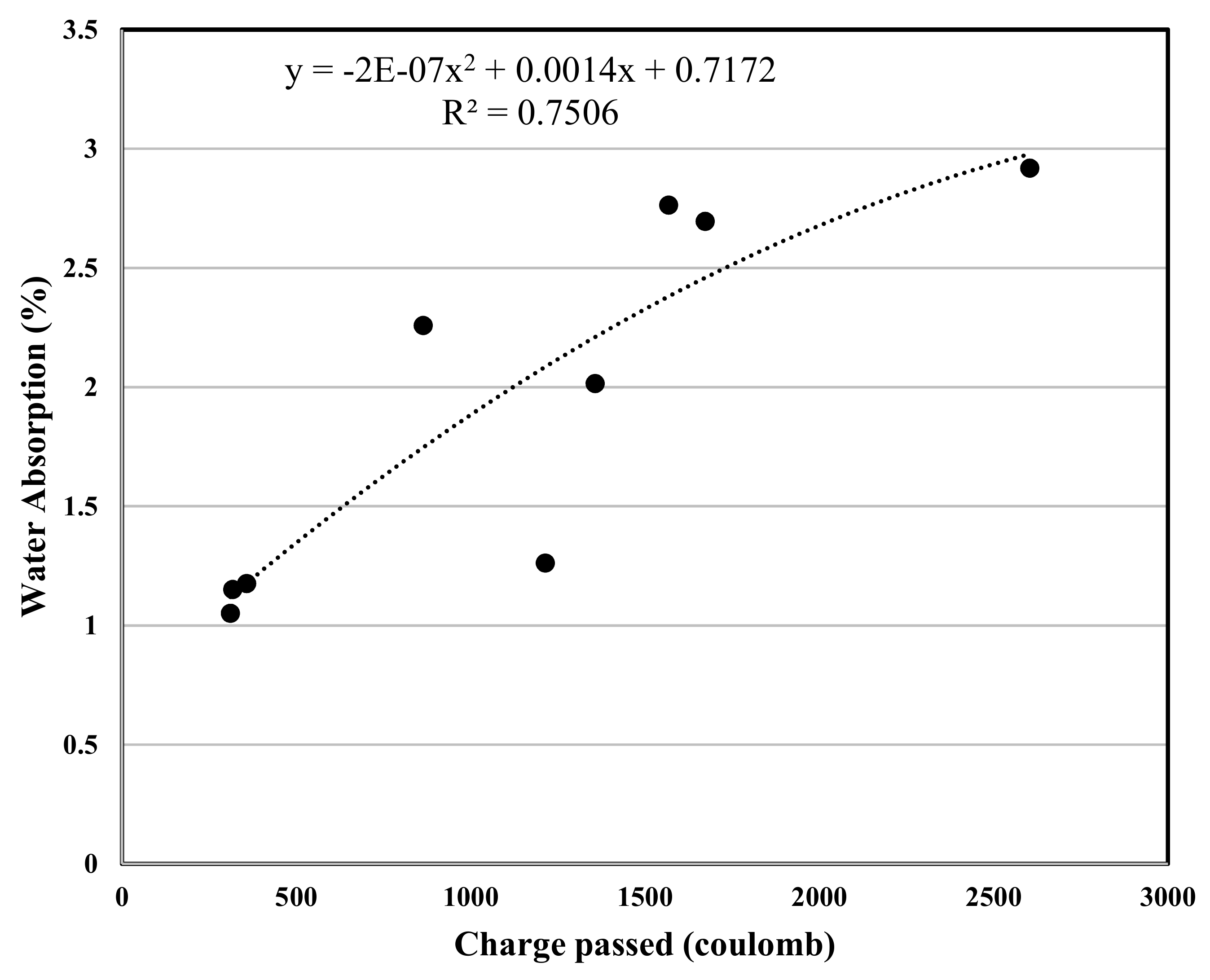

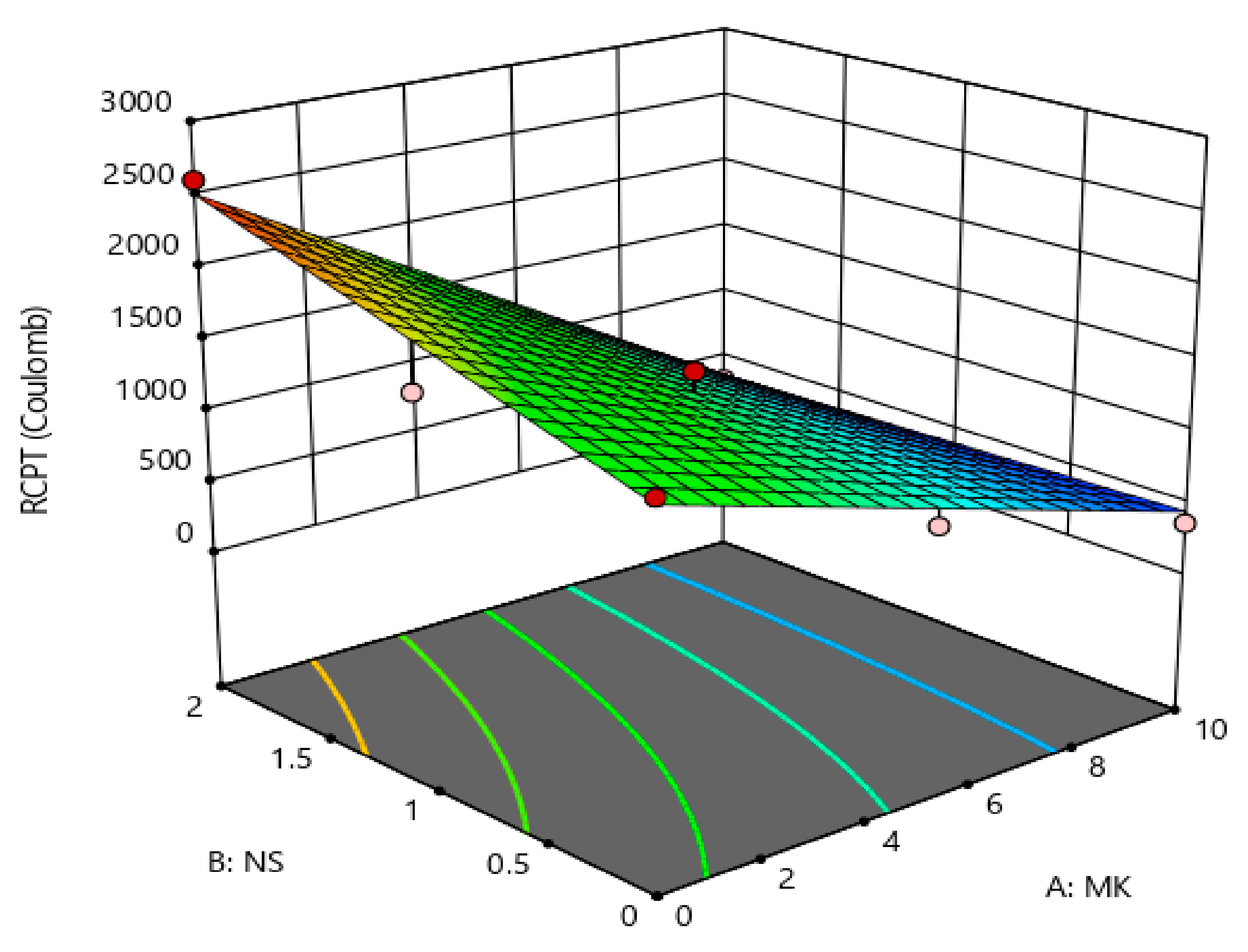
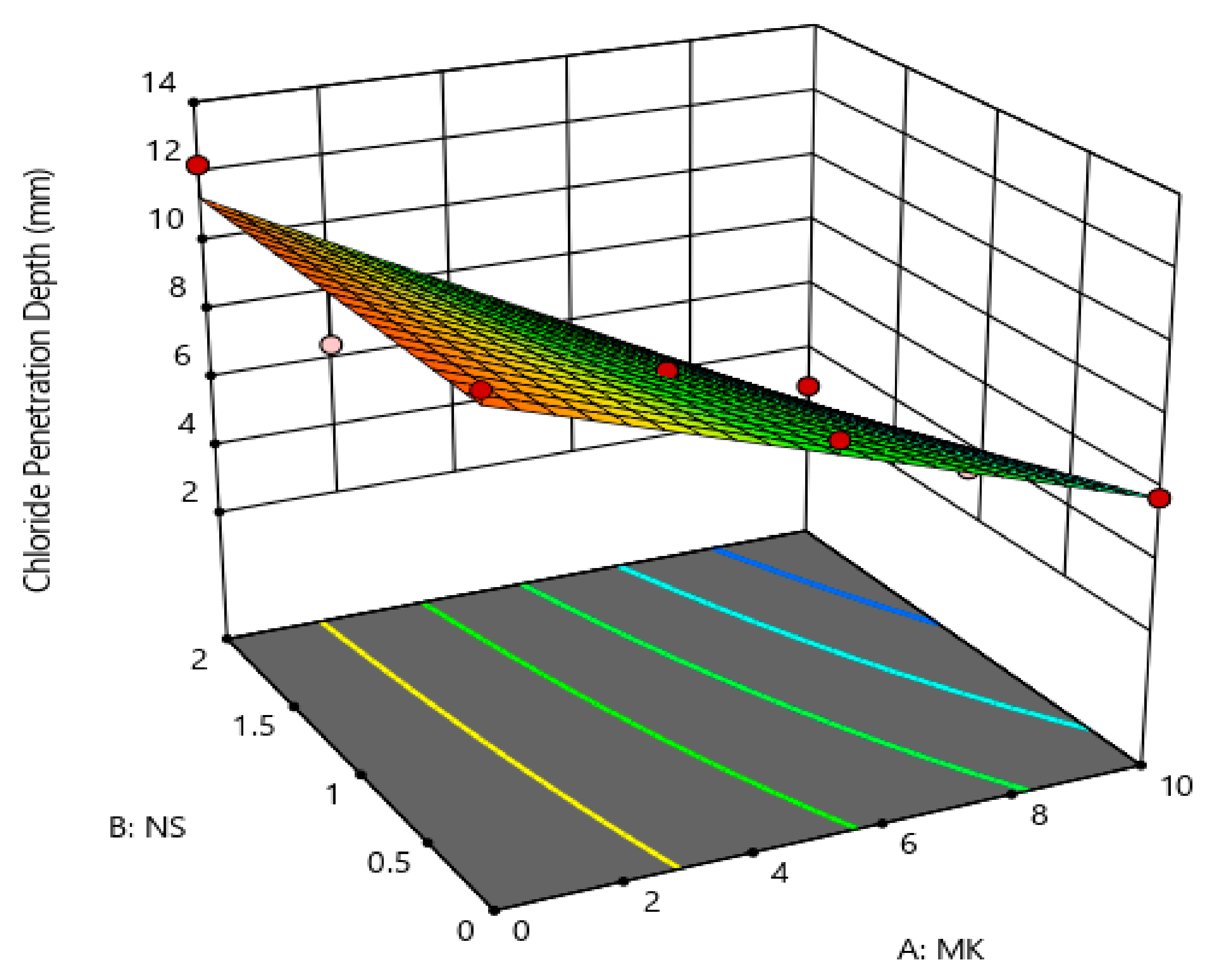
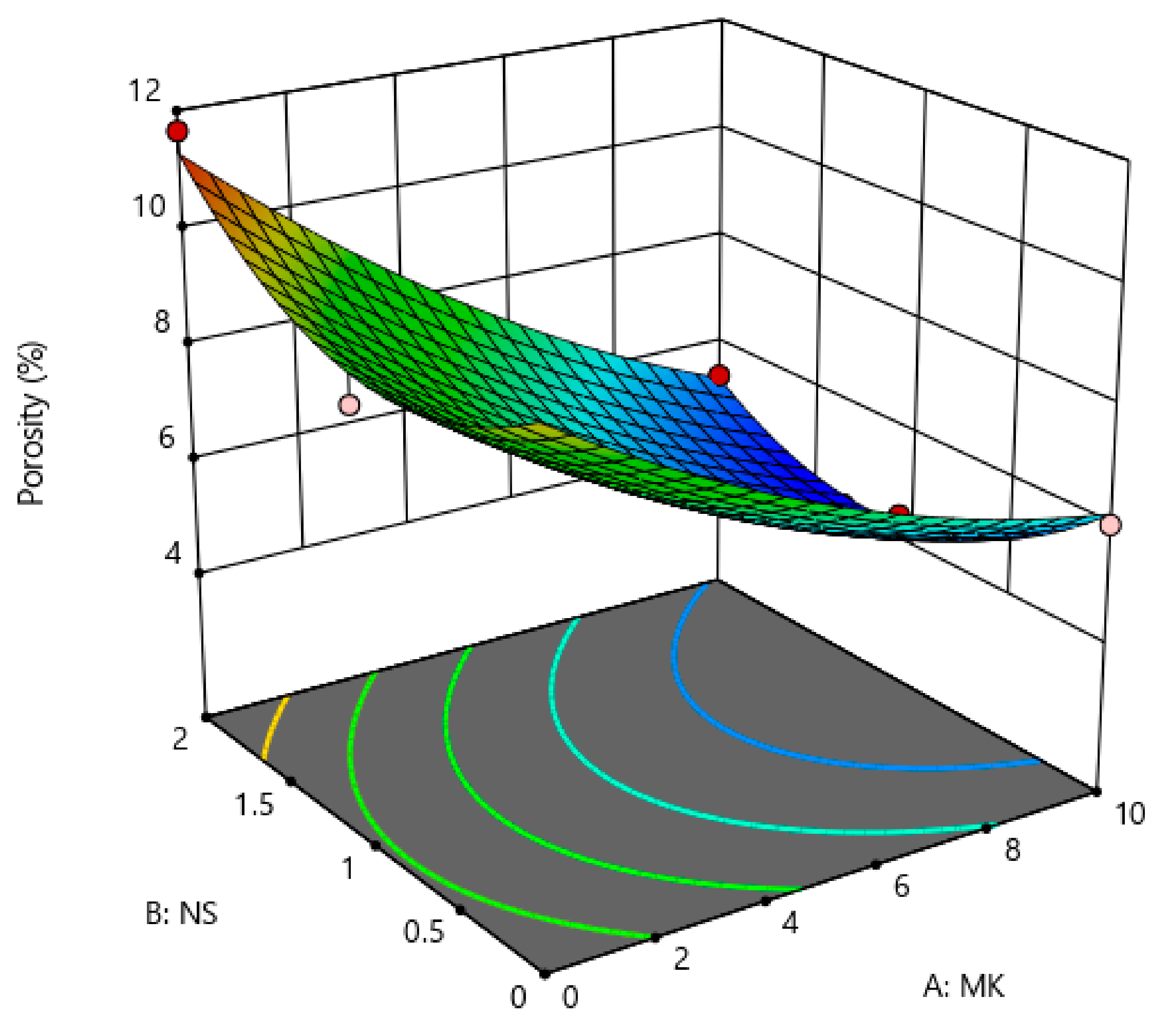
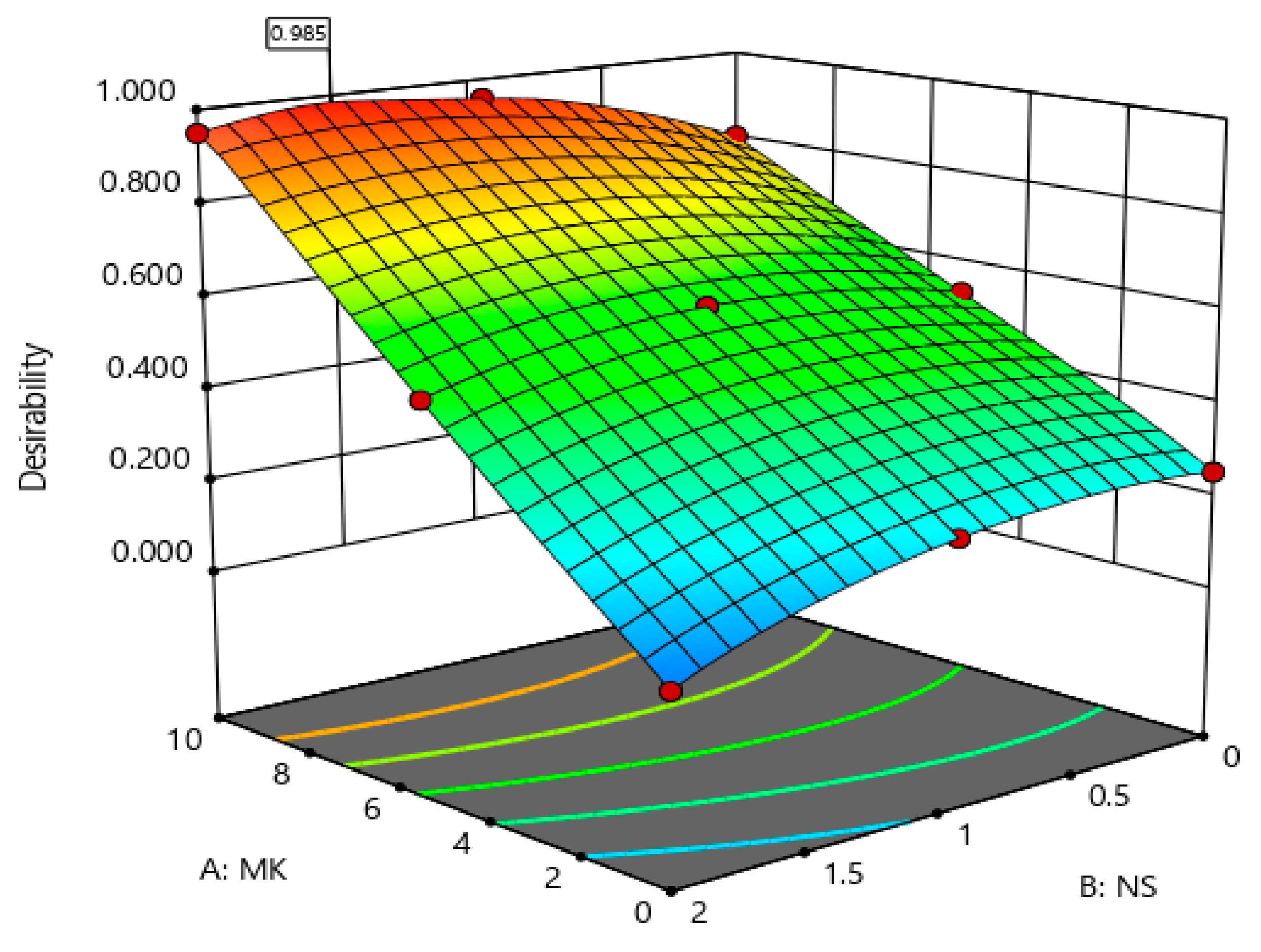
| Chemical Composition % | Physical Properties | ||||||||
|---|---|---|---|---|---|---|---|---|---|
| Constituents | CaO | Al2O3 | SiO2 | MgO | Fe2O3 | SO3 | LOI | BET Surface area (m2/g) | Density (g/cm3) |
| OPC (Portland cement) | 62.85 | 4.59 | 25.21 | 1.70 | 2.99 | − | 2 | 1.066 | 3.15 |
| MK (metakaolin) | 0.58 | 35.1 | 53.3 | 0.27 | 2.73 | 0.14 | 7.4 | 11.440 | 2.50 |
| Description of Item | Quality |
|---|---|
| Appearance | High dispersive white powder |
| Heat of reduction (%) (105 °C 2 h) | ≤3 |
| Loss on ignition (%) (950 °C 2 h) | ≤6 |
| SiO2 (dry base) (%) | ≥92 |
| SiO2 (dry base) (%) (950 °C 2 h) | ≥99.8 |
| Carbon content (%) | ≥0.3 |
| Specific surface area (m2/g) (BET law) | 100±25 |
| PH value | 6.5–7.5 |
| Surface density (g/mL) | ≤0.15 |
| Dispensability (%) (%) (CCL4) | ≥80 |
| Oil-absorbed value (mL/100g) | ≥250 |
| Average particle size (nm) | 10–25 |
| Mix ID | Factors | Kg for 1 m3 Concrete | SP (%) | Slump (mm) | w/b | |||||
|---|---|---|---|---|---|---|---|---|---|---|
| MK (%) | NS (%) | Cement | MK | NS | Sand | CA | ||||
| CM (100%) | 0 | 0 | 500 | 0 | 0 | 735 | 990 | 0.5 | 100 | 0.35 |
| C-MK-5% | 5 | 0 | 475 | 25 | 0 | 735 | 990 | 0.6 | 101 | 0.35 |
| C-MK-10% | 10 | 0 | 450 | 50 | 0 | 735 | 990 | 0.83 | 130 | 0.35 |
| C-NS-1% | 0 | 1 | 495 | 0 | 5 | 735 | 990 | 0.8 | 102 | 0.35 |
| C-NS-2% | 0 | 2 | 500 | 0 | 10 | 735 | 990 | 0.95 | 107 | 0.35 |
| C-MK-5% NS-1% | 5 | 1 | 475 | 25 | 5 | 735 | 990 | 1.1 | 117 | 0.35 |
| C-MK-5% NS-2% | 5 | 2 | 475 | 25 | 10 | 735 | 990 | 1.35 | 105 | 0.35 |
| C-MK-10% NS-1% | 10 | 1 | 450 | 50 | 5 | 735 | 990 | 1.2 | 130 | 0.35 |
| C-MK-10% NS-2% | 10 | 2 | 450 | 50 | 10 | 735 | 990 | 1.6 | 110 | 0.35 |
| Compressive Strength 28 Days | Source | Sum of Squares | DF | Mean Square | F-Value | P-Value | Remarks | Contribution Parameters |
| MK | 451.36 | 1 | 451.36 | 133.21 | <0.0001 | significant | 80.15 | |
| NS | 19.73 | 1 | 19.73 | 5.82 | 0.0466 | significant | 3.50 | |
| MK2 | 32.97 | 1 | 32.97 | 9.73 | 0.0169 | significant | 5.85 | |
| NS2 | 20.66 | 1 | 20.66 | 6.10 | 0.0429 | significant | 3.67 | |
| MK×NS | 38.44 | 1 | 38.44 | 11.35 | 0.0119 | significant | 6.83 | |
| Error | 0 | 4 | 0 | |||||
| Rapid Chloride Permeability Test 28-Days | ||||||||
| MK | 3933360 | 1 | 3933360 | 111.15 | <0.0001 | significant | 86.93 | |
| NS | 301952 | 1 | 301952 | 8.53 | 0.0170 | significant | 6.67 | |
| MK×NS | 289444 | 1 | 289444 | 8.17 | 0.0188 | significant | 6.39 | |
| Error | 0 | 4 | 0 | |||||
| Chloride Penetration Depth 28-Days | ||||||||
| MK | 81.77 | 1 | 81.77 | 163.11 | <0.0001 | significant | 90.97 | |
| NS | 5.19 | 1 | 5.19 | 10.35 | 0.0105 | significant | 5.77 | |
| MK×NS | 2.92 | 1 | 2.92 | 5.83 | 0.0389 | significant | 3.25 | |
| Error | 0 | 4 | 0 | |||||
| Porosity 28-Days | ||||||||
| MK | 35.58 | 1 | 35.58 | 364.72 | 0.0001 | significant | 80.89 | |
| NS | 0.06 | 1 | 0.066 | 0.68 | 0.4374 | - | - | |
| MK2 | 0.90 | 1 | 0.90 | 9.31 | 0.0186 | significant | 2.06 | |
| NS2 | 6.24 | 1 | 6.24 | 63.99 | 0.0001 | significant | 14.19 | |
| MK×NS | 1.19 | 1 | 1.19 | 12.18 | 0.010 | significant | 2.70 | |
| Error | 0 | 4 | 0 | |||||
| Equation Coefficients | Concrete Property | ||||
|---|---|---|---|---|---|
| Compressive Strength (MPa) | Charge Passing (Coulomb) | Chloride Penetration Depth (mm) | Porosity (%) | ||
| Constant | C | +91.58 | +1207.31 | +7.69 | 6.12 |
| MK | A1 | +8.67 | −809.67 | −3.69 | −2.44 |
| NS | A2 | −1.81 | +224.33 | −0.93 | 0.10 |
| MK2 | A3 | +3.46 | - | - | 0.57 |
| NS2 | A4 | −2.73 | - | - | 1.50 |
| MK×NS | A5 | +3.10 | −269.0 | −0.85 | −0.54 |
| R-square | 0.95 | 0.93 | 0.95 | 0.98 | |
| Adj R-Square | 0.93 | 0.91 | 0.93 | 0.97 | |
| Factors and Responses | Goal | Lower Limit | Upper Limit |
|---|---|---|---|
| Metakaolin (%) | In range | 0 | 10 |
| Nano silica (%) | In range | 0 | 2 |
| Compressive strength (MPa) | Maximum | 76.54 | 103.6 |
| RCP (Coulombs) | Minimum | 311 | 2604 |
| Chloride penetration depth (mm) | Minimum | 2.8 | 12.25 |
| Factors and Responses | Optimum Values and Expected Responses | Experimental Results of Optimum Replacement Ratio | Error (%) |
|---|---|---|---|
| MK (%) | 10 | ||
| NS (%) | 1.55 | ||
| Compressive strength (MPa) | 103.6 | 104.3 | 0.67 |
| RCP (coulombs) | 375 | 371 | 1.33 |
| Chloride penetration depth (mm) | 3.14 | 3.00 | 4.45 |
| Porosity (%) | 4.47 | 4.40 | 1.56 |
| Desirability | 0.985 | ||
| Mean Error | 2.00 |
© 2019 by the authors. Licensee MDPI, Basel, Switzerland. This article is an open access article distributed under the terms and conditions of the Creative Commons Attribution (CC BY) license (http://creativecommons.org/licenses/by/4.0/).
Share and Cite
Shafiq, N.; Kumar, R.; Zahid, M.; Tufail, R.F. Effects of Modified Metakaolin Using Nano-Silica on the Mechanical Properties and Durability of Concrete. Materials 2019, 12, 2291. https://doi.org/10.3390/ma12142291
Shafiq N, Kumar R, Zahid M, Tufail RF. Effects of Modified Metakaolin Using Nano-Silica on the Mechanical Properties and Durability of Concrete. Materials. 2019; 12(14):2291. https://doi.org/10.3390/ma12142291
Chicago/Turabian StyleShafiq, Nasir, Rabinder Kumar, Muhammad Zahid, and Rana Faisal Tufail. 2019. "Effects of Modified Metakaolin Using Nano-Silica on the Mechanical Properties and Durability of Concrete" Materials 12, no. 14: 2291. https://doi.org/10.3390/ma12142291






